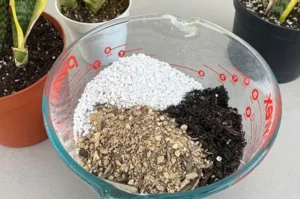Watering snake plants might seem simple, but many people make mistakes that can harm snake plant health. Whether you are new to gardening or have been taking care of snake plants for years, it’s important to know about these common watering mistakes and how to avoid them. In this article, we will explain them in easy language, covering key topics like evaporation, foliage, watering schedules, moisture levels, and soil moisture levels.
Watering at the Wrong Time
Watering at the wrong time of day is one of the biggest mistakes. When you water snake plants during the heat of the day, much of the water will evaporate before it can reach the roots. The best time to water is early in the morning or in the late afternoon. At these times, evaporation is reduced, and the snake plants have the chance to absorb the moisture they need.
Overwatering
Overwatering is another common problem that harms snake plants. Giving snake plants too much water can suffocate the roots and lead to root rot. It is important to understand the right moisture levels for each type of snake plant. Before watering, check the soil moisture level by sticking your finger into the soil about an inch deep. If it feels moist, you do not need to water.
Overwatering can also wash away important nutrients from the soil. Follow a watering schedule and adjust it based on the weather, the plant’s needs, and the type of soil.
Underwatering
Underwatering happens when snake plants don’t receive enough water. If the soil becomes too dry, the snake plant can become weak and stop growing. This problem often occurs when snake plant owners forget to water or think the snake plants can go longer without water.
To avoid underwatering, regularly check the soil moisture level. If the top inch of soil is dry, it is time to water.
Watering the Foliage
Watering the foliage instead of the soil is another mistake many people make. Water on the leaves can lead to fungal infections and can even burn the leaves if the sun is strong. Snake plants take up water through their roots, not their leaves.
Always water at the base of the plant so that the water reaches the roots. Only spray the leaves if you are cleaning them or removing pests.
Tips to Avoid Watering Mistakes
- Understand your snake plant’s needs: Learn about the moisture levels each snake plant requires.
- Follow a watering schedule: Regular watering helps prevent overwatering and underwatering.
- Use proper watering tools: A watering can with a narrow spout helps direct water to the roots.
- Add mulch: Mulch helps maintain soil moisture levels and reduces evaporation.
- Monitor the weather: Adjust your watering based on the weather forecast.
- Check soil moisture regularly: Use your finger or a moisture meter to test soil conditions.
- Choose well-draining soil: Good soil helps prevent root rot and overwatering issues.
Watch snake plant appearance: Yellow or drooping leaves can signal watering issues.
Frequently Asked Questions (FAQs)
How do I know if I am overwatering my snake plant?
Signs include yellow leaves, soft stems, and consistently soggy soil.
When is the best time to water snake plant?
Early morning or late afternoon helps reduce evaporation.
Can watering leaves cause harm?
Yes, watering foliage can lead to fungal issues and leaf burn.
How can I check soil moisture level?
Insert your finger into the soil about an inch deep. If it’s dry, water the plant.
What should I do if my plants are underwatered?
Water them thoroughly and adjust your watering schedule going forward.
Conclusion
Watering correctly is essential for healthy snake plants. By avoiding mistakes like watering at the wrong time, overwatering, underwatering, and watering foliage, you can help your snake plants grow strong and beautiful. Remember to consider factors like evaporation, plant foliage, watering schedule, moisture levels, and soil moisture level. With a little care and attention, your garden will flourish naturally.






